| |
 |
 |
 |
 |
 |
|
 |
|
 |
|
 |
|
|
 |
 |
|
|
 |
| |
 |
 |
 |
 |
 |
 |
 |
 |
 |
 |
|
|
|
|
 |
 |
 |
 |
 |
| |
| |
| |
 The
Armenian National Committee of France (CDCA) is the largest
French-Armenian grassroots political organization. Working
in coordination with a network of offices, chapters and
supporters throughout the European Union and
sister-organizations around the world, the CDCA actively
advances the concerns of the Armenian community in France
and in the EU on a broad range of issues. The
Armenian National Committee of France (CDCA) is the largest
French-Armenian grassroots political organization. Working
in coordination with a network of offices, chapters and
supporters throughout the European Union and
sister-organizations around the world, the CDCA actively
advances the concerns of the Armenian community in France
and in the EU on a broad range of issues. |
 Official Website
Official Website
 Contact
Contact |
|
| |
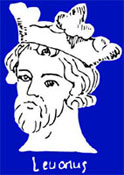 The
German-Armenian Society was founded in Berlin in 1914. Apart
from Johannes Lepsius, Protestant priest and first chairman,
its original members included the journalist Paul Rohrbach
and the Armenian author Avetik Issahakyan. The
German-Armenian Society was founded in Berlin in 1914. Apart
from Johannes Lepsius, Protestant priest and first chairman,
its original members included the journalist Paul Rohrbach
and the Armenian author Avetik Issahakyan.
The aims of the DAG are to promote mutual understanding
between Germans and Armenians and to safeguard the interests
of Armenians living in Germany. Furthermore, the DAG defends
the rights and interests of Armenian minorities, including
in Turkey and other Middle Eastern countries. |
 Official Website
Official Website
 Contact
Contact |
|
| |
|
|
| |
| |
| |
| |
| |
| |
| |
| |
| |
| |
| |
| |
| |
| |
| |
| |
|
|
| |
| |
| |
Hayastantsi
The term Hayastantsi refers to a
person from the republic of Armenia (Hayastan in Armenian), as
opposed to an Armenian from Iran (Parska-Hay), Russia (Rusa-Hay),
the US (Amerika-Hay), Holland (Hollanda-Hay)etc. In Armenia
itself, the locals are usually called Teghatsi - meaning "from
this place".
|
| |
| |
| |
| |
| |
| |
| |
| |
| |
| |
| |
| |
| |
| |
|
|
| |
| |
| |
| |
| |
| |
| |
| |
| |
| |
| |
| |
| |
| |
| |
| |
| |
|
|
| |
| |
| |
| |
| |
| |
| |
| |
| |
| |
| |
| |
| |
| |
| |
| |
| |
|
|
| |
| |
| |
| |
| |
| |
| |
| |
| |
|
|
| |
| |
| |
| |
| |
| |
| |
|
|
| |
| |
| |
| |
| |
| |
| |
| |
| |
| |
| |
| |
| |
| |
| |
| |
| |
|
|
| |
| |
| |
| |
| |
| |
| |
| |
| |
| |
| |
| |
| |
| |
| |
| |
| |
|
|
| |
| |
| |
| |
| |
| |
| |
| |
| |
| |
| |
| |
| |
| |
| |
| |
|
|
| |
| |
| |
| |
| |
| |
| |
| |
| |
| |
| |
| |
| |
| |
| |
| |
| |
| |
| |
| |
|
|
|
|
|
|
|
Armenian
diaspora community in the world
Beirut
From
Armeniapedia.org
After the Armenian
Genocide,
Beirut
had the largest number of Western
Armenians in the world, and became
the center of the Western Armenian
world. As conflict hit one middle
eastern country after another, many
Armenians moved to the west, and
eventually Los Angeles
became the biggest Diaspora
community, with the probably
exception of
Moscow
after Armenia gained independence
and mass emigration took place from
there as well.
The
Armenian community in Beirut is
still large, and the suburb of Bourj
Hammoud is still the biggest
Armenian neighborhood.
Armenians Remember Victims of 1915
Massacre
By Rym Ghazal Daily Star staff
The Daily Star, Lebanon April 25,
2006
http://www.dailystar.com.lb
Turkey still denies targeting
minority community
BEIRUT: Thousands of Armenians from
all over Lebanon gathered at Bourj
Hammoud Stadium on Monday to
commemorate the 91st anniversary of
the Armenian genocide, demanding
that Turkey "recognize and apologize
for" the massacre committed by the
Ottoman Turks in 1915.
"It was the first massacre of the
20th century to which the whole
world turned a blind eye," former
Minister Alain Tabourian told the
crowd.
The gathering was attended by 35,000
Armenians who came wearing the
Armenian flag but singing the
national Lebanese anthem as they
marched into the stadium in the
Armenian suburb of Beirut.
"Turkey tried to wipe us out of
existence, but we survived and were
reborn with new citizenships," said
Tabourian, who also thanked Lebanon
for having welcomed Armenian
refugees who fled Turkey. "We never
forgot our roots."
He also thanked representatives from
the government and President Emile
Lahoud, along with Lebanese Forces
MP Strida Geagea, who attended the
commemoration ceremony.
Beginning on April 24, 1915,
Armenians say about 1.5 million
Armenians "were massacred" by the
Ottoman Turks as part of a
government-led "genocide," a term
Turkey has fiercely and consistently
rejected for decades. Ankara also
says the dead numbered
300,000-500,000.
Survivors fled to Syria and Lebanon,
with the latter now home to the
largest Armenian community in the
Arab world, made up of about 75,000
descendants of those who fled the
1915-1917 violence.
"In order for the Armenians to open
a new page with Turkey, it has to
acknowledge and admit its crime
against us, and apologize for
committing the highest kind of
atrocities possible against human
beings," Tabourian said.
"Their admission of this crime would
benefit them and help them
accomplish their dream of entering
the European Union, and would give
us our peace and compensation which
are rightfully ours," he added,
referring to EU demands that Turkey
face its past and expand freedom of
speech before it can qualify to
enter the union.
Apart from the speeches, which were
mainly delivered in Armenian, white
balloons were released in honor of
those killed in the bloodletting and
in hope that peace can finally be
realized between Turkey and the
Armenians.
"It is rather unlikely they Turkey
will admit it, but we have to prove
that as Armenians, we still exist,
and just as Palestinians are
fighting for their land, so are we,"
said one participant at the event,
Anto Narguizian, 17.
"Turkey's alliance with the United
States is very strategic, both
economically and geographically, so
the United States will not agree
that such a mass genocide occurred,
even if most European states have
agreed to this," he added. "But if
America does not agree, Turkey will
not return the land it has taken
from the Armenians, and will not
repay all the damages it has
caused."
Narguizian's mother, Maral, who did
not attend the commemoration, told
The Daily Star: "Everyone has their
way of expressing their beliefs and
what they stand for; I would rather
express myself through monetary aid
to local charities and churches."
But she added that these "protests
need to be done, to ask for our
rights, which have long been
ignored."
Moscow
Moscow, the capital of
Russia,
has a large Armenian community,
perhaps the largest outside of
Yerevan
in the world.
Hollywood
(where Little Armenia area has been
designated)
Hollywood
became the heart of Southern Californias
Armenian community during the 1970s.
With immigrants from the middle east
moving to Los Angeles
en mass to escape conflict in
Lebanon, Iran, Iraq, Israel and
other countries, Hollywood was the
primary destination. Armenians from
other parts of California also moved
there - and eventually a part of the
area was officially named Little Armenia
in 20??. This happened after the
decline of the central Armenian
community, however. As the Armenian
immigrants became financially
established, many moved to the
hills, to
Glendale,
to Northridge, etc.
As the Soviet Union
loosened controls on emigration, a
massive flood of
Hayastantsi
(Armenians from the Armenian
Republic) moved to LA, and
especially the established Armenian
communities in Hollywood and
Glendale. The number may have
exceeded 100,000.
Many of the Armenian shops and
restaurants popular today in
Glendale or across the LA area began
in Hollywood (though some began in
Lebanon before that). These include
Zankou Chicken,
Panos Pastries and Carousel. Sassoun
Bakery, Falafel Arax, Karabakh Meat
Market and others remain only in
Hollywood.
West
Hollywood
FLAGS AT HALF-STAFF TO HONOR
ARMENIAN GENOCIDE VICTIMS
NBC4, CA April 24 2006
WEST HOLLYWOOD, Calif. -- Flags will
fly at half-staff in West Hollywood
Monday to honor Armenian victims of
genocide.
An estimated 1.5 million Armenians
died between 1915 and 1923 in the
waning days of Turkey's Ottoman
Empire.
Today is the 91st anniversary of
what many Armenians consider the
start of the genocide, when Turkish
authorities arrested 200 Armenian
community leaders.
The Turkish government says
allegations of genocide have never
been proven.
Turkish Ambassador Nabi Sensoy, in
response to the Public Broadcasting
Service documentary "Armenian
Genocide," said last week that
"Armenian allegations of genocide
have never been historically or
legally substantiated."
The
West Hollywood City Council has
passed a resolution "condemning the
human rights violations of the
Turkish government," according to
City Councilman Jeffrey Prang's
office. The resolution was
introduced by Prang and Councilwoman
Abbe Land.
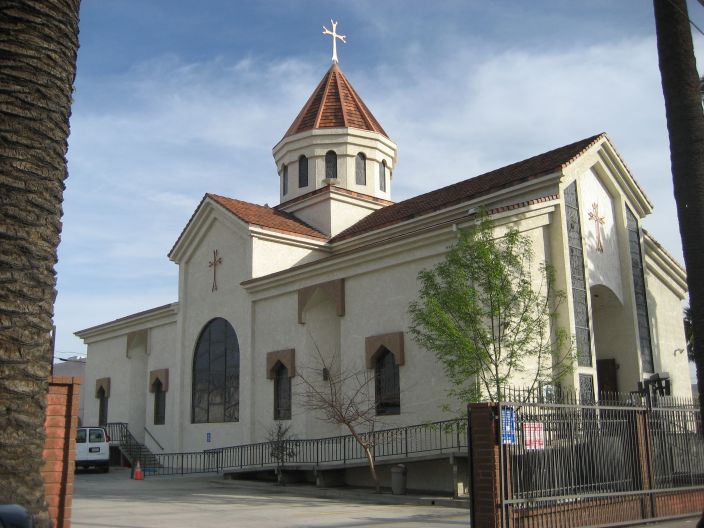
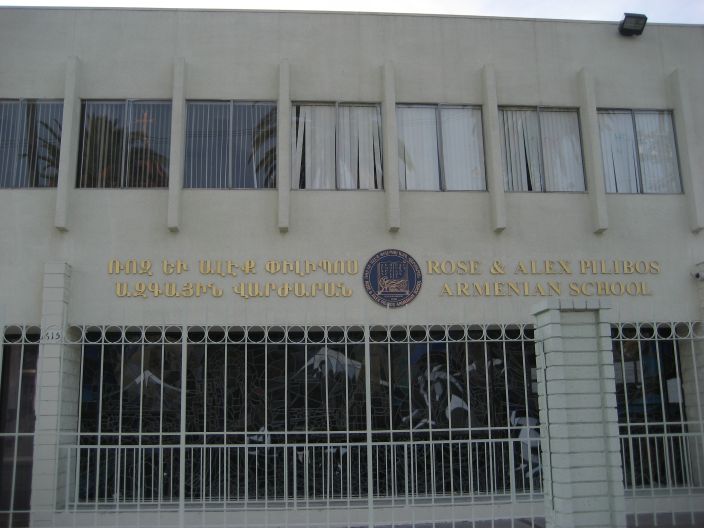
St. Gregory Armenian Church in Hollywood Pilibos Armenian School in Hollywood
Glendale
Glendale, California hosts the second
largest Armenian population of any city
in the USA (Los Angeles is first). It
has the highest percentage of residents
of Armenian descent, most of which have
arrived to the city in the last two
decades. Though exact numbers of
Armenians are hard to determine in the
United States (because the census does
not ask about Armenian ancestry), it is
known that about 40% of the students in
Glendale Unified School District are
Armenian.
With a total city population of nearly
200,000 - the number of Armenians is
roughly 80,000. As of January 2007,
three of five city council members
are Armenian.
The city of Glendale is located in Los
Angeles County, and is home to the third
largest Armenian community outside of
Armenia, after Moscow
and Los Angeles.
Los
Angeles Times
Aug 8 2005
New Era for Glendale Armenians
Even as the ethnic group marks the
milestone of a majority on the City
Council, it struggles with internal
diversity and a changing community.
By Amanda Covarrubias
Times Staff Writer
Drive down Central Avenue in the
heart of Glendale and the telltale signs
of the city's long Armenian influence
quickly become apparent.
The cursive Armenian writing
advertises bakeries, coffee shops
and restaurants that serve such
specialties as sweet honey baklava
and lamb kebabs.
Glendale has been a haven for
Armenians for generations, a point
of entry for immigrants from
Armenia, as well as people of
Armenian descent from Turkey,
Lebanon, Iran and the former Soviet
Union. They now make up 40% of the
San Fernando Valley city's 210,000
residents.
But it was not until this year that
the city's Armenian community marked
a major political milestone: winning
a majority on the City Council.
Many Armenian Americans are proud of
the election results, saying they
illustrate how a community that once
stood on the fringes of local
government now is playing a central
role. But they also are quick to say
the Armenian American majority on
the five-member council does not
reflect a homogenous community.
Despite its size, the population is
highly diverse. Wealthy second- and
third-generation Armenian Americans
live in tony neighborhoods in the
hills above the city, while recent
immigrants struggle in lower-income
neighborhoods.
Bridging this divide is a task with
which social service organizations
and the Armenian Church struggle.
Sometimes the new immigrants
complain that their high
expectations about life in America
are difficult to achieve, especially
with limited English skills.
"Some of these people can't get jobs
that will pull them out of their
financial situation," said Angela
Savoian, regional chairwoman for the
Armenian Relief Society. "They get
deeper into debt because their
children want what their neighbors
have.... It's much more difficult to
be poor in this country than where
they came from."
Sometimes parents work two or three
jobs to make ends meet, leaving
their children unsupervised for
hours. In the past, authorities have
said the situation helped boost the
ranks of Armenian street gangs, a
problem seen five years ago when an
Armenian gang member fatally stabbed
a Latino student outside Hoover High
School.
In recent years, police say,
Armenian gang activity has declined.
But both Glendale police and the FBI
are becoming increasingly concerned
about Armenian organized-crime rings
linked to drug dealing and
robberies.
"I see a lot of materialism and
anger and resentment," said Father
Vazken Movsesian, who runs a youth
drop-in center at St. Peter Armenian
Church, across the street from
Hoover High. "I have to keep telling
them: 'Appreciate all that America's
giving you.' "
The newly elected Armenian American
council members have vowed to help
newcomers integrate into the
community, fight youth crime and
bring about changes that will ease
some of the parents' problems.
Among the steps they can take, said
Councilman Ara Najarian, is to
encourage the Police Department to
hire more Armenian American officers
and work to secure more federally
funded housing for low-income
families. The city has 1,500
vouchers for government-funded
housing and a waiting list of 9,000.
"Armenian Americans don't all think
the same way or walk in lock step,"
Najarian said. "We're very diverse,
from the poorest in the city to the
richest; some are professionals and
some are newly arrived with their
own language and customs. It's not
like we had 60,000 people who came
from Armenia yesterday and settled
in Glendale."
Once a bastion of white,
Anglo-Saxon, Protestant political
power, the city is now home to about
85,000 Armenians, one of the largest
populations outside Armenia itself.
In addition to Central Avenue's
bustling shopping district, Glendale
is home to at least half a dozen
Armenian-language newspapers, and
local cable TV outlets are filled
with Armenian-produced talk shows
and public affairs programming.
"When I first came to California to
go to school in the 1950s, there
were few Armenians in Glendale,"
said Richard
Dekmejian,
director of the USC Institute of
Armenian Studies. "Most of the
Armenians were in West Adams, Boyle
Heights, a few in the Valley. There
were a small number of Armenians in
Hollywood, but they grew very fast."
Armenian families have lived in the
city since the 1920s, but
immigration did not transform its
social fabric until the 1970s, when
Armenians who had scattered across
the globe during the era of genocide
in Turkey uprooted themselves in
rapid succession from Lebanon, Iran
and the then-Soviet Republic of
Armenia. They were forced to leave
these countries because of world
events that prevented them from
practicing their Christianity freely
and to escape anti-Armenian
discrimination.
Many were drawn to Glendale, as well
as East Hollywood and Fresno.
In many respects, the Armenian
American councilmen represent the
diaspora. Bob Yousefian was born in
Iran, moved to Lebanon as a teenager
and later followed his family to the
United States; Rafi Manoukian was
born in Beirut and immigrated to the
United States in 1975; and Najarian,
whose parents emigrated from
Armenia, is a Cleveland native whose
family moved to Glendale in 1980.
The leaders consider former Gov. George
Deukmejian
and former Mayor Larry Zarian,
the first Armenian American on the
City Council, to be their role
models. Zarian, who served on the
council from 1983 to 1993, was
invited to Armenia for an official
state visit after becoming the first
Armenian American mayor of a
relatively large U.S. city.
"I think what the community is doing
in Glendale is something it has not
been able to do in many other parts
of the world," Zarian said. "Our
parents, who come from Lebanon,
Jordan,
Egypt,
the Soviet Union
and Iran,
were not able to participate in the
governmental political process and
run for public office.
"But their children became lawyers,
teachers and doctors and said: 'We
want to be able to get involved.' "
The growing Armenian population did
not always experience a smooth
transition. In 2000, when city
officials lowered the American flag
to mark Armenian
Genocide
Commemoration Day, some longtime
residents complained about all the
attention the event was receiving.
The day recognizes the killing of
Armenians by Ottoman Turks between
1915 and 1923.
Around the same time, officials
became concerned about violent
clashes between Armenian and Latino
students at a local high school.
More recently, the FBI's Eurasian
Crime Task Force and the Glendale
Police Department have worked
together to combat organized crime
involving Armenians from the former
Soviet Union and the United States.
Authorities said the groups have
taken root in the last five years,
dealing primarily in white-collar
crimes involving auto insurance,
credit cards, identity theft and
welfare fraud. But the rings have
also been linked to several murders.
In March, the FBI filed charges
against members of a Russian
Armenian organized-crime ring
accused of plotting to smuggle $2.5
million in illegal guns into the
United States.
There have also been tensions within
the Armenian community. Earlier this
year, Manoukian and members of the
Armenian Council of America accused
each other of politicizing the
city's annual Armenian Genocide
Commemoration activities.
Arguments broke out over who would
serve on the committee that plans
the events. Vasken Khodanian,
chairman of the Armenian Council of
America, said Manoukian excluded all
but one representative from his
committee and filled it with members
who have ties to the Armenian
National Committee.
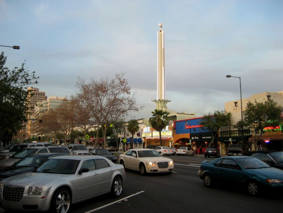
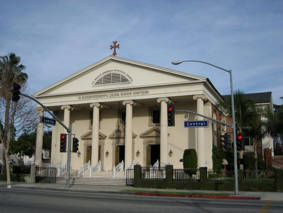
Brand Avenue in
Glendale,
California.
St. Mary's Armenian Apostolic Church in
Armenian owned Alex Theatre visible Glendale,
California.
Zankou Chicken
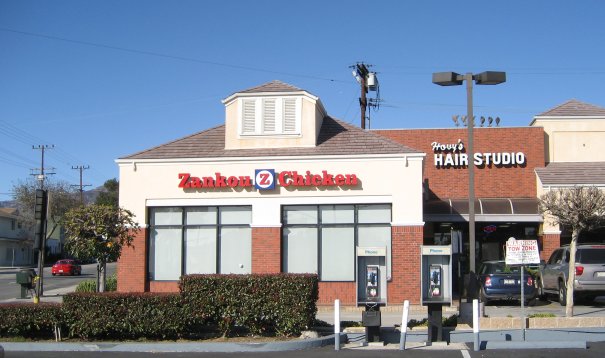
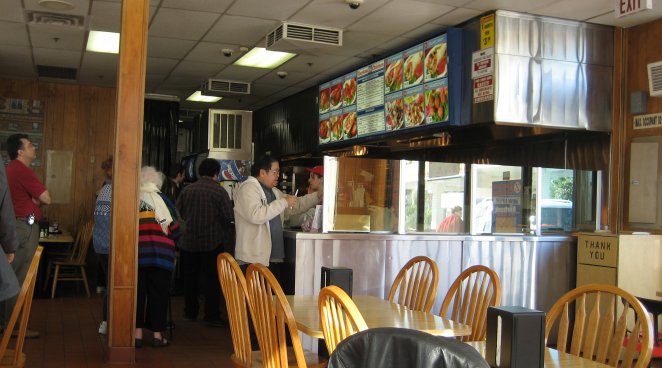
Glendale branch
The first
Zankou Chicken opened in 1962 in the heart of
Beirut, Lebanon by Vartkes Iskenderian and his
family. After serving Lebanon's diverse
community for 20 years, Vartkes and his son Mardiros
Iskenderian
sold the business and moved to Los Angeles,
California. In 1984, Zankou opened its doors in
Hollywood at the corner of Sunset and Normandie.
Centered in the heart of America's motion
picture industry, Zankou attracted thousands of
aspiring actors, writers, artists, and musicians
with its delicious, inexpensive meals.
In 1992,
Mardiros Iskenderian opened Zankou Chicken in
Glendale. The restaurant was heavily crowded on
opening day, and the immense success of that
branch led him to open further Zankou Chicken
restaurants in Van Nuys, Anaheim, and Pasadena.
Zankou's legendary garlic sauce and
exceptionally fast food still attract new
customers every day.
Quotes about Zankou
Chicken
That Zankou is
legendary is no doubt. Here are some worthy
quotes about it.
- Chicken chains
have cult followings. Los Angelenos worship
Zankou's Armenian chicken and its pungent
garlic sauce. -New
York Times
(Feb 23 2005)
- "The best
chicken in town at any price: moist, juicy
and fragrant." - L.A. Times
Zankou Chicken is also
mentioned in the Beck song, Debra.
Toronto
Toronto is the capital
of Ontario, Canada, and is home to an
Armenian community of approximately 20,000
individuals. Between the 1920s and the
1980s, the majority of Armenian Canadians
lived in the Toronto area. A number of
orphan boys that arrived from historic
Armenia after the Armenian Genocide of 1915,
who were known as
The Georgetown Boys,
settled in Toronto after leaving their
school. Today the Armenian community of
Toronto is concentrated in the Victoria Park
and Agincourt neighborhoods of the city.
There are four
Armenian churches in Toronto (1 Diocese
Apostolic, 1 Prelacy Apostolic, 1
Protestant, 1 Catholic) and there are other
Armenian churchs in neighboring suburbs
(including Mississauga).
The Armenian
Apostolic (Prelacy) church on Victoria Park
features a daycare, and is adjacent to the
Armenian Community Centre which is
affiliated with the Armenian National
Committee (ANC). The church features a
genocide monument by artist Arto Chakmajian.
The AGBU Toronto
Center (aka The Alex Manoogian Center) at
the intersection of Progress Avenue and
Markham Road is adjacent to the AGBU
Zaroukian Day School and the Holy Trinity
Armenian Apostolic Church (Diocese). There
is a genocide monument designed by a local
Armenian Canadian architect.
Seven Oaks nursing
home at Military Trail and Ellesmere Rd. in
Scarborough opened in 1989 and serves 250
residents. A number of beds are designated
for residents of Armenian heritage, and
volunteers from the Armenian community are
active in the home. Source:
http://www.Toronto.ca/homesfortheaged/sevenoaks.htm
For more
information on the history of Armenian
Canadians, see
Armenians in Ontario
and Quebec.
Jordan
Armenians
of Jordan: A community with duel identity
by Mike Derderian
The Star
May 2, 2003 Friday
JORDAN
(Star) - The first question I am asked when a
person knows I am Armenian is, "Aren't you a bit
far from home? What made you Armenians immigrate
in the first place?"
The
presence of Armenians in the Arab
world dates back to the 13th century. However,
it wasn't until 1914, just before the WWI, at
the time of the Armenian Genocide,
leading to their mass immigration, that Armenian
communities began to be formed in this part of
the world.
Armenians
came to Jordan, believe it or not, on foot "Walking
all the way from their motherland through Turkey,
under the scorching sun, children, women and the
elderly made their way to the deserts of Syria
and Jordan. Some were killed on the way, others
perished either from exhaustion or butchered at
the hands of heartless soldiers.
The ones
who were lucky to survive this grueling journey
were received and generously treated by Arabs.
Al Sharif Hussein offered them protection and
told his Arab subjects through a formal letter
they should be treated well and their language
and religion must be respected.
The letter
still exists and is part of the many documents
that Armenians are proud of, always reminding
them of the humanistic role Arabs played in
helping Armenians to survive.
Today, 24
April, Armenians are meeting at the Sorp Tatyos
Church to commemorate the memory of those who
died in 1914 for it is through their devotion
and persistence the Armenian language and
tradition survived. Armenian communities in
various Arab countries are indebted to those who
gave them homes and a new chance in life.
In search
for a better life, some refugees decided to stay
in Syria, Lebanon, Palestine and Jordan,
formerly known as Belad Al Sham, others traveled
to Europe and America.
Armenians
in Jordan and through out the world were able to
prove themselves skillful craftsmen in fields
like photography, art, gold, Jewelry, medicine,
architecture, car mechanics and shoe making.
The early
Armenian refugees first resided in places like
Ma'an, Petra, Al Karak, Irbid and Zarqa in 1915.
Yet it wasn't until 1928 and 1930 when they
began to move to Amman and live in what is known
today as the Armenian alley in Al Ashrafiyah
today, it composes the Armenian Church, a school
and two clubs.
But the
first Armenian school was in Al Karak
established in 1928 to teach the Armenian
alphabets to children orphaned during WWI. In
1933 their own private school with a little
chapel came to exist.
In 1960
the Armenian bishop of Jerusalem made generous
contributions to build the current church called
(Sorp Tatyos, meaning St Tatyos. The head of the
Armenian Church is the Archbishop Vahan Topalian.
The school
is called Yuzbeshian-Colbenian consisting of an
elementary school and a Kindergarten. The number
of students is about 140 and admits children
from KG up to the 6th grade after which students
are transferred to other non-Armenian schools.
The school teaches Armenian, English and Arabic.
Armenians
also have two clubs in Al Ashrafiyah, Al Watani
club and Al Homentmen and are considered to be
part and parcel of the Armenian life style.
The
current Homentmen club dates back to1960. Edward
Tchackmakian, president of the club said, "The
club is a place for social gathering, offering
and arranging different activities, most
importantly we have a basketball team for all
ages, and a large scouts movement of 92."
Aline
Benyan, a journalist at the Jordan Times, and
head scouts leader in The Homentmen said, "We
aim to make our children learn how to become
good Jordanian citizens. "We have two identities
which is something that makes us proud, however,
it is also essential to give importance to our
roots."
The Watani
Club has been in existence since 1946 and was
registered in 1955 and its current place dates
back to 1973. "The activities held at the club
vary between cultural activities, sports, and
drama for we have a stage that allows our
members the chance to act, in addition to an
Armenian folklore dance group that reflects the
artistic and cultural aspects of Armenia," said
Anto Lepegian, its president.
Varougan
Sarkisian, 76, had a business in medical
supplies and is now retired, said his
father-in-law Isaac Korkian known as Isaac
Saliba, was the first Armenian to be given
Jordanian citizenship.
"I'm
Jordanian, and I love Jordan. I'm also Armenian."
He further added, "lately a monument was built
in Armenia to commemorate how Arabs helped us
during our time of hardship."
The
Armenian Relief Society. was founded in 1956, as
a charitable organization. Maral Derderian,
president of the society said, "The society
works under the supervision of the Union of
Voluntary Societies in Amman. Their work
revolves around helping the poor and needy by
giving them monthly salaries, we also help
students who require money for school and
college tuitions.+ACI-." She continued that the
society consists of 7 active members including
herself and about 135 members and all work on
voluntary basis.
There are
about 4000 Armenians living in Jordan, the new
generations of Armenians were born in Jordan and
all consider themselves as Jordanian citizens of
Armenian roots who have deep affinity to the
Kingdom. So if you ask any Armenian born in
Jordan, a question about his identity, he will
proudly say "I'm a Jordanian."
Egypt
From Armeniapedia.org
EGYPTIAN ARMENIANS TODAY
Armenpress Dec 5 2005
Most
of current Armenian Egyptians who are
permanent residents of Egypt were born in
Egypt. Armenian Egyptians are full Egyptians
with an extra cultural layer. Their small
community numbered around 8,000(before 1952
there around 60,000 Armenians in Egypt) is
in Cairo and Alexandria.
Clubs,
schools, and sports facilities run by
Armenian Egyptians, the Armenian Church and
the apolitical structure of the Armenian
community have a very important role in
unifying Armenians in Egypt. Armenian
Egyptians work in the private sector, as
successful business men, skilled
handicraftsmen (especially as jewelers).
Since the beginning of the nineteenth
century, Armenians fled to Egypt from the
Ottoman Turkey with a range of skills in the
field of business, commerce, and finance. In
addition they came to Egypt mastering
foreign languages. Nowadays, Armenians who
master foreign languages work in offices and
branches of international organizations as
well as foreign embassies in Cairo.
The
Armenian community operates two benevolent
and one cultural associations, the Armenian
Red Cross Association, the Armenian General
Benevolent Union and the Houssaper Cultural
Association. The community has four social
clubs in Cairo and two in Alexandria, in
addition to three sporting clubs in the
capital and two in Alexandria. There is one
home for the elderly, and many activities
for young people, including a dance troupe,
Zankezour, a choir, Zevartnots, and a
children's choir, Dzaghgasdan.
Egyptian Armenians run two daily papers and
one weekly publication. Armenian Egyptians
are divided into Orthodox (Gregorians) and
Catholics. Catholics comprise the majority
of Armenian Egyptians. There are five
Armenian churches in Egypt, one in
Alexandria and four in Cairo: The Prelacy of
the Armenian Church in Egypt, which is under
the jurisdiction of Holy Etchmiadzin, is the
primary guardian of community assets such as
endowments, real estate in the form of
agricultural land and other property
bequeathed by generations of
philanthropists. The most famous Egyptian
Armenia is Boghos Nubar Pasha (1825 - 1899),
Egyptian statesman, politician and the first
Prime Minister of Egypt. He served as Prime
Minister of Egypt three times during his
career.
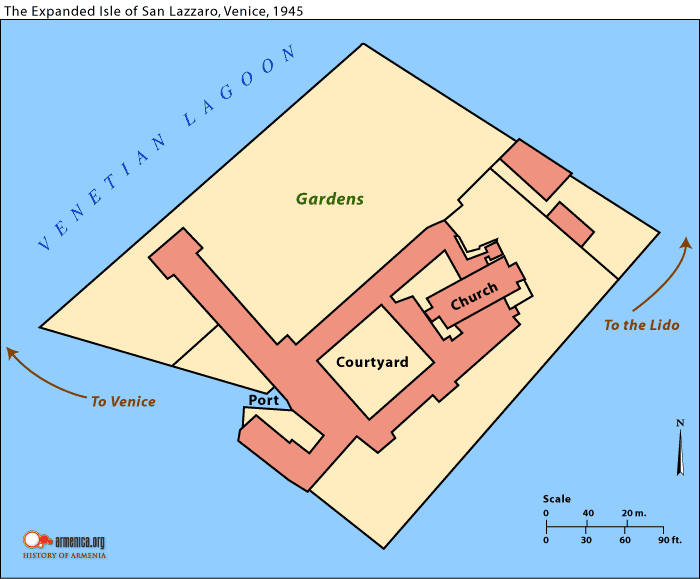 |
Venice
Home of San
Lazzaro Island.
Once had an Armenian quarter,
Armenian street, and thriving
Armenian merchant community
linked to
Cilicia.
Map of San Lazzaro Island. |
San Lazzaro
degli Armeni is a small island
in the Venetian lagoon, lying
immediately west of the Lido;
completely occupied by a monastery
that is the mother-house of the
Mekhitarist Order (a christian
catholic order), the island is one
of the world's foremost centers of
Armenian culture.
The islet's
isolation, at some distance from the
principal islands forming the actual
city of Venice, made it an ideal
location for the quarantine station
and leper colony founded there in
the twelfth century, receiving its
name from St. Lazarus, patron saint
of lepers. Abandoned in the
sixteenth century, in 1717 it was
given by the ruling council of
Venice to a group of Armenian monks
that had escaped from Turkish
persecution, five years earlier
placed themselves under the
protection of the Pope, and
eventually made their way to Venice.
Mekhitar and his seventeen monks
built a monastery, restored the old
church, and enlarged the island to
its present 3 hectares, about four
times its original area.
Its founder's
temperament and natural gifts for
scholarly pursuits immediately set
the Mekhitarist Order in the
forefront of Oriental studies: the
monastery published Armenian
historical, philological and
literary works and related material,
renowned for their scholarship and
accuracy as well as for the beauty
of the editions, on its own
multilingual presses, which, sadly,
shut down in 1991, although an an
eighteenth century printing press
may still be seen. S. Lazzaro houses
a 150,000-volume library, as well as
a museum with over 4,000 Armenian
manuscripts and many Arab, Indian
and Egyptian artifacts collected by
the monks or received as gifts.
The monastery
and its gardens, noted for its
peacocks, may be reached by
vaporetto (#20 from S. Zaccaria)
every 40 minutes and offers daily
tours at 15.30 to visitors. The
boats leave S. Zaccaria at 15.10 -
15.50 - 16.30, etc. The boats leave
S. Lazzaro at 16.05 - 16.45 - 17.25,
etc.
Groups of
visitor may ask a private tour with
different schedule. Father Vertanes
and other fathers guide the tours in
several different languages.
It also has a
long tradition of hospitality to
scholars and students of Armenia,
among whom Lord Byron, who studied
Armenian there during much of the
year 1816 and who is remembered by a
permanent exhibition.
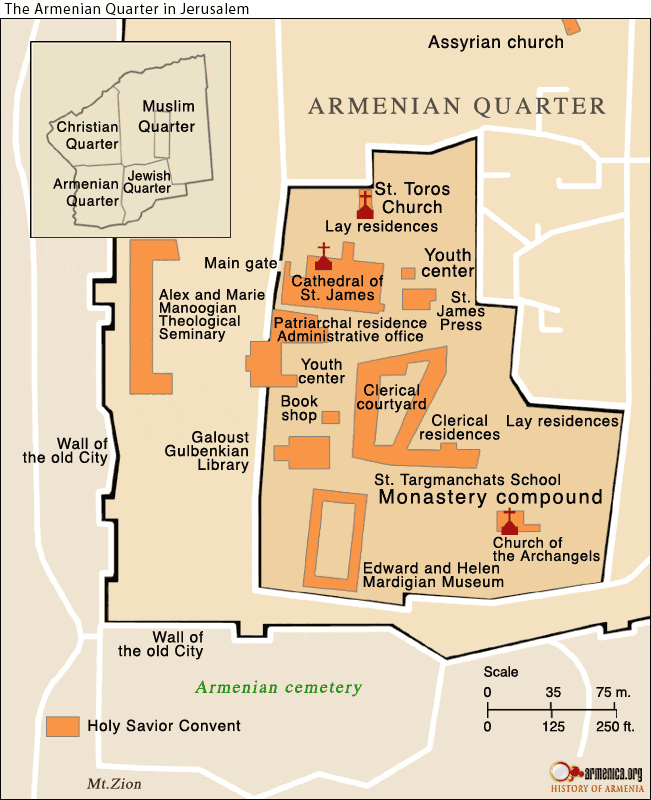 |
Armenian Quarter of
Jerusalem
Armenian Quarter of
Jerusalemrmenians have an
important portion
of the Old City of
Jerusalem
called the Armenian Quarter.
The other three quarters are
the Muslim, Christian
and Jewish quarters.
The
Armenian Quarter is home to
the St. James Armenian
Church and the
Edward
and Helen Mardigian Museum
of Armenian Art and History.
It also has the
Calouste Gulbenkian Library.
The
Armenian Quarter is one of
the four quarters of the Old
City
of Jerusalem. It might
appear that the Armenian
quarter would be a part of
the Christian Quarter, since
virtually all Armenians
residing in Jerusalem are
Christians, yet for
historical reasons the
Armenian quarter has
remained separate and has
not suffered the same
disruptions as the other
quarters over the last
thousand years. Although the
smallest of the four
quarters, with the fewest
residents, the Armenians and
their patriarchate remain
staunchly independent and
present a vigorous presence
in the Old City. The story
of the Armenian quarter, its
growth and decline, its
assets
and community, is one often
overlooked in studies of
Jerusalem.
Map of Armenian Quarter of
Jerusalem |
The Armenian
and Jewish peoples have several
things in common: Both have a
defined religion and nationality,
both have a past of continuous
pogroms and persecutions, and both
have been subjected to genocide -
the Armenians during the first World
War and the Jews during the second.
Both peoples have realized their
age-old dreams of national
independence in the modern period,
we in 1948, and the Armenians in
1991.
The uniqueness
of the Armenian Quarter is its being
placed within its own walls, in
addition to the walls of the Old
City. The Quarter, sort of its own
enclosed ghetto, takes up around a
sixth of the territory of the Old
City, and is home to around 2,000
Armenian, both secular and religious
(another point in common with the
Jewish people). Most earn a
livelihood from local businesses,
artwork (like the famous ceramics),
printing and academe.
London
Home to a small but
well organized
Armenian community.
Many of the
Armenians who fled
Northern Cyprus
after the Turkish
invasion fled to
England,
and especially
London.
Paris
Paris has
one of the largest Armenians
communities in
France.
The Louvre
has an ancient Armenian
khachkar
in it's collection.
King Levon
VI
(1342-1393), the last king of
Cilicia
(Lesser Armenia) is buried at
St. Dennis Cathedral, along with
the French royalty.
The
Birth of a Community
by
Jean-Claude Kebabdjian
Paris
— An Armenian-style church at
Germigny-des-PrËs south of
Pithiviers on the River Loire,
lost like a lonely jewel in the
depths of France, is one of the
examples of early contacts
between the French and Armenian
people dating back to between
the 10th and 12th centuries.
Religious
contacts were established during
this period and these are
documented in the country’s
oldest historical records. The
French were in no doubt, even
way back, that Armenians would
play an important role in the
future.
The
Crusaders were a glorious
turning point. Political and
commercial links flourished
between the French and Armenians.
First of all there were blood
ties, stretching right up to
almost the royal palaces. The
last Regent of the Armenian
Kingdom of Cilicia , Leon VI of
Lusignan, of French stock, died
in 1393 in Paris and was buried
at the Saint Denis Basilica just
to the north of the French
capital.
After that,
Cardinal Richelieu and Colbert
helped the Armenians set up
trading posts.
Succeeding
waves of immigrants
History
was to gather pace and the skies
were to darken. The era of the
Genocide dawned, the French
sometimes present, and sometimes
not. After the Treaty of
Lausanne in 1923, the French
authorities needed workers. The
Armenian refugees and orphans
crammed into Turkey, Egypt and
Lebanon, arrived by the
boatloads to Marseilles and
journeyed to the mines and
factories around Marseilles,
Valence, Grenoble, Lyons and
Paris.
There, a
quarter of a million Armenians
settled down into tight little
communities of between 2,000 and
4,000 people. The foundations of
theArmenian community in France
had been set.
The
Armenian immigrants who arrived
between 1920-30 fought and died
for France on the battlefields
of World War II and in the
Resistance during the occupation
by Nazi Germany. They paid the
price for their assimilation and
integration.
Their
offspring, the first generation
Armenians born in France,
provided many celebrities like
the singer Charles Aznavour and
the film director Henri Verneuil,
both the sons of refugees, or
later still, world Formula One
driving champion Alain Prost,
whose father was Armenian.
Armenian
refugees were also prominent in
the arts. Paris is full of faded
memories of artists famous in
their days, entertainers who
graced the prestigious stages of
the French capital. Alice
Sapritch, GrÈgoire Aslan and
Jacques Helian are only a few of
them.
French-Armenian ties were
preserved and consolidated over
the years. Thousands of new
immigrants who arrived after the
troubles in Turkey
(in 1956), Lebanon
(in 1975) and Iran
(in 1979) comprised the next
wave of immigration. Today, many
youngsters who are the product
of this movement are completing
their studies in France, setting
up Armenian households and
sending their children to
Armenian language schools.
Faced with
the growing demand and the
awakening of cultural identity,
the future looks bright.
Institutions with firm
foundations:
The Armenian
General Benevolent Union,
established in 1906, and its
founder Boghos
Nubar
moved in 1921 to Paris, the
diplomatic and political hub of
the Armenian Question. AGBU
chapters were set up in Paris,
Lyon, Valence, Marseilles and
Nice.
The
Armenian Social Aid Association,
operating Armenian retirement
homes, was founded before this
period and is unique to France.
National institutions, and first
and foremost the Armenian Church
of Paris founded in 1905, were
very soon to co-exist in Paris,
playing a fundamental role in
defending and protecting the
refugees.
Today,
Armenian classes are organized
in many localities with full
bilingual kindergartens and
primary schools near Paris and
Marseilles attended by several
thousand children and youths.
Armenian is currently a valid
option counting toward the
Baccalaureate, the French High
School certificate.
A caring
community
In 1983,
the bloody attack at the Paris
Orly airport, blamed on a badly
divided
Armenian
Secret Army for the Liberation
of Armenia
(ASALA), raised a public outcry.
Unlike the Orly attack, the
occupation of the Turkish
Consulate in Paris in 1981 was
enthusiastically supported by
young and old, and by all shades
of public opinion.
The
campaign to pass the resolution
condemning the
Armenian
Genocide
at the European Council
unleashed on June 19, 1987 at
Strasbourg a demonstration rare
in its emotional intensity.
The
earthquake on December 7, 1988
in Armenia and the huge
mobilization of the French
Armenian community in aid of the
victims served not only to
underline how numerous they were,
but also proved that contrary to
what was thought, they did care.
The exhaustive effort made by
French Armenians to provide
humanitarian and logistical aid
to the quake victims was
probably unprecedented.
The
passage of time, despite some
heart-rending tragedies along
the way, has opened the doors to
social and human progress which
is at once powerful and worthy.
Successive waves of immigrants
have brought with them their own
contributions. The Armenian
legacy can be found in trade,
industry, science, fashion and
the arts.
A lot has
changed since the first
Armenians arrived in France.
They have rapidly become an
extremely dynamic economic,
social and intellectual
component of French society.
The Armenian
Community of the Netherlands
There is
evidence of Armenians in the Low
Countries, that is Belgium,
Holland, and Luxembourg,
beginning in the eleventh
century. Trade became active,
however, in the thirteenth and
fourteenth centuries, when Dutch
and Flemish merchants arrived in
Cilicia and Armenian trading
houses opened in the Low
Countries. Armenians brought in
carpets, dyes, cotton, and
spices, concentrating their
trade in the city of Bruges,
specifically St. Donat's Church
square, where they traded their
goods for woollen cloth, Russian
furs, Spanish oil, and other
items brought from the four
comers of Europe.
After the fall of Cilicia,
Armenian refugees arrived in
Bruges where they were supported
by a number of Flemish Christian
charities. In 1478 Armenians
built a large hostel in Bruges
which became the "Armenian
Hospice." By the end of that
century Armenians began to move
to Amsterdam, the new center of
commerce in the region. Dutch
sources record Armenian
merchants selling pearls and
diamonds there in the second
half of the sixteenth century.
Armenian commerce in Amsterdam
received a major boost when
Armenian merchants from
Iran
began trading in Western Europe
in the first half of the
seventeenth century. Dutch
merchants went to Isfahan and
some even settled in New Julfa,
while Armenians opened trading
houses in Amsterdam. The first
Armenian Bible was printed in
1666 in that city, by Voskan
Vardapet. Armenians from
Amsterdam also introduced the
first printing press to Iran.
Soon after the conclusion of a
trade treaty between the Turks
and the Dutch in 1612, Armenian
merchants from the Ottoman
Empire arrived in Amsterdam.
Silk was the primary item traded
by the Armenians there, as in
the rest of Europe, and they
continued to control the Dutch
silk trade until the
mid-eighteenth century.
According to Dutch sources there
were some 500 Armenians living
in Amsterdam, concentrated in
the Monnikenstraat, Dykstraat,
and Keiserstraat streets and
selling their wares in the
Qoster ("Eastern") Market.
In 1713 the Armenians
constructed an Armenian Church
in Amsterdam and received
permission from Etchmiadzin to
have their own priest. A number
of Armenian merchants were
wealthy enough to have their own
ships flying the Dutch colours
and to be escorted by armed
frigates on their journeys to
Smyrna. A hundred years later,
however, due to various European
conflicts, particularly the
blockade enforced during the
Napoleonic wars, as well as the
rise of English trading
companies, the Armenian
community had lost its economic
power in the Netherlands. By the
mid-nineteenth century, the
Armenian church of Amsterdam was
closed down and eventually sold.
By the end of the nineteenth
century most of the Armenian
communities in Europe had
reached the low ebb of their
social and economic influence in
their adopted lands. No one
could predict that cataclysmic
events at the end of that
century and the first two
decades of the twentieth would
bring new, and very different,
Armenian immigrants to the
shores of Eastern and Western
Europe.
The Armenian communities of
Belgium and Holland experienced
Europe's world wars firsthand.
During the First World War, many
Armenians, who were still
Turkish citizens, left Belgium
for Holland to escape the German
onslaught and from fear of being
sent back to Turkey to be
drafted. Most returned after the
war and a chair in Armenian
studies was established in the
University of Brussels in 1931,
with the famed professor
Nicholas Adontz as its first
chair holder.
The community in
Holland had all but disappeared,
when it got a minor influx from
the Armenians who had left Dutch
Indonesia in the 1950s after the
nationalist government took over
there. More Armenians came to
Holland from Iran, Turkey and
Lebanon in the 1980s and
eventually managed to repurchase
the Armenian church in
Amsterdam, which had been closed
in the 1850s. Although barely
10,000 strong, the Armenian
communities of Belgium and
Holland are culturally active.
Source: A History of the
Armenian People Volume II
By: George A. Bournoutian
TOP
|
|
|
|
Copyright © 2008 www.kaloustian.nl -
www.kaloustian.eu. All Rights Reserved. |
|